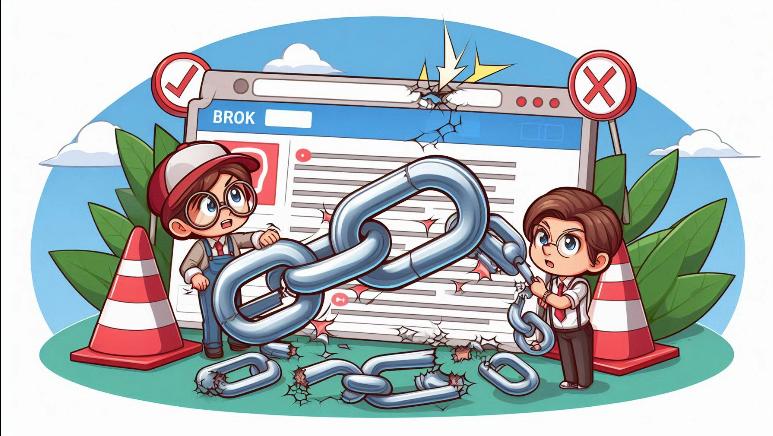Broken links are pesky URLs that no longer lead to the intended page and are more common than you might think. A link breaks when a webpage is moved or deleted without updating references pointing to that page. Other times, it could be due to typos in the URL or changes in the site structure.
When visitors stumble on a 404 error instead of getting the expected content, it’s like hitting a dead end. Frustration mounts, and people may bounce right off your site. Let’s not overlook the SEO aspect either. Search engines might penalize your site for having too many broken links, lowering your site’s visibility in search results.
The ripple effect of broken links can severely damage a brand’s reputation and erode trust. Potential customers may see it as a sign of neglect or unprofessionalism. Even big businesses sometimes find themselves caught in the web of broken links, losing valuable traffic. Making sure users find what they need swiftly and effortlessly keeps them returning, reinforcing site reliability and trust in your brand.
Effective Strategies for Identifying Broken Links
Finding broken links isn’t tricky if you have the right tools. Several online tools are designed to scan your website for any link hiccups quickly. Popular choices include Screaming Frog, Ahrefs, or SEMrush. These can efficiently crawl through your pages to pinpoint problematic URLs.
Regular site audits can be your best defense against link decay. By systematically checking links, you’ll catch issues before they snowball into bigger problems. Make it a routine, perhaps monthly or quarterly, depending on your site’s size and frequency of content updates.
Remember that both internal and external links deserve your attention. Internal links connect your website pages, while external links guide users to other sites. Tracking both types is crucial because, even though external links are out of your control, they still reflect on your site’s credibility.
Webmaster tools like Google Search Console offer insights into your site’s link health. They can alert you to 404 errors, helping you keep everything neat. Using these tools, site owners can ensure visitors stay on the right path, boosting user satisfaction and reputation.
Fixing and Preventing Future Broken Link Problems
Managing broken links requires not only fixing them when they appear but also preventing them from occurring in the first place. Start by addressing any broken links identified through your tools. Redirects are your friend here. Setting up a 301 redirect can help guide users to the right place without them even knowing there was a detour.
Consistent updates to your website’s structure and content can greatly minimize link problems. When moving or deleting pages, ensure all associated links are updated accordingly. A content management system (CMS) with easy URL management features can simplify this task.
Keeping an eye on your link health means being proactive, not reactive. Monitoring tools should be part of your routine, catching potential link issues as they arise. You maintain a healthy, user-friendly website by integrating link checking into day-to-day operations.
Don’t underestimate the value of bringing in professionals if things feel overwhelming. SEO experts can provide detailed insights and handle complex link audits, giving you peace of mind. A small investment in professional help can lead to significant returns in traffic and user satisfaction.


Yo Laurie,
Thanks for sharing this article about fixing dead links! Seriously, I totally get what it’s saying, ’cause I’ve been there with my own stuff.
It’s so true how annoying it is when you click on something and it’s just a “oops, nothing here” page. Like, instant trust fail, right? And yeah, Google totally hates that stuff and tanks your search ranking, which is a major bummer.
I like how the article tells you exactly what to do to find and fix those broken links, like using those tools Screaming Frog and Ahrefs. Doing regular checks of your site is a no-brainer, way better than waiting for everything to fall apart.
And it’s not just the links on your own site, but the ones going somewhere else too. Even if it’s not your fault if an external link breaks, it still makes your site look kinda bad. I’ve used Google Search Console to keep an eye on this stuff and get alerts for those 404 errors. Super helpful!
Totally agree that stopping broken links before they even happen is the key. Whenever you mess with your site or delete pages, you HAVE to update all the links. If your website thingy has good URL tools, it makes it way easier to keep track of everything.
And yeah, if things get super complicated, calling in the pros makes sense. Sometimes you just need someone else to look at it and figure out how to fix all the link craziness.
So basically, this article is a good reminder that you gotta keep your links healthy on your website. It makes things way better for people using your site and helps you not get buried in Google. Thanks for sharing this helpful stuff, Laurie!
Later,
Eric
Thanks so much for your awesome comment—I’m glad the article hit home for you! You’re absolutely right: nothing kills trust faster than clicking a link and landing on a dead end. It’s such an easy thing to overlook, but the impact on user experience and SEO can be huge.
I love that you’re already using tools like Google Search Console, which is super bright! And yep, broken external links can sneak up on you just as easily, even if they’re not technically your fault. Staying on top of them shows you care about your site and visitors.
I totally agree—preventing broken links in the first place is the real win. A little upkeep goes a long way. Thanks again for sharing your experience—it’s always great to hear how others are tackling this in the real world!